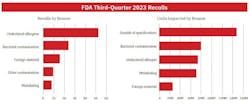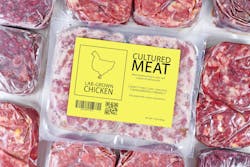Heavy metals and other chemicals in foods, a two-year-out deadline on traceability and increased federal scrutiny of foreign suppliers. Many of the same issues that faced the food & beverage industry at the start of 2023 remain as we enter 2024.
But there are two new factors in year’s preview of food safety in the new year: There’s a “new” FDA charged with fixing them, and California, among other states, is putting pressure on the agency to move faster.
On the USDA side, the Agriculture Dept. is continuing its war on salmonella in chicken and scrutinizing “Product of USA” label claims, and its stewardship of the 2025 Dietary Guidelines will be in the spotlight before the end of the year.
The “new” FDA
With the FDA providing the most oversight over most of the food & beverage industry, how that agency looks and acts by the end of this year will have a huge impact on food safety.
After the agency took a beating on several fronts in 2022, Commissioner Robert Califf promised a major overhaul of the food side of FDA. The two key actions were creation of a single Human Foods Program (HFP) where there were separate programs for food safety, nutrition, and regulatory affairs; and the appointment of a single deputy commissioner to oversee that new HFP and all things related to foods and beverages, where last year there were three leaders.
Last August, Califf named James Jones as the first deputy commissioner for human foods. He had no FDA, USDA or food industry experience, although he formerly worked at the U.S. Environmental Protection Agency. Notably, he was a member of the Reagan-Udall Foundation review that recommended this overhaul of the FDA.
The structure and functioning of the new Human Foods Program are a work in progress and largely a bureaucratic matter. It’s hopefully a better way of dealing with the things FDA always has faced.
In mid-October, Jones gave a brief update on progress: “We’ll start … by focusing our efforts on three priority areas: preventing foodborne illness, decreasing diet-related chronic disease through improved nutrition and safeguarding the food supply through the safe use of chemicals and dietary supplements.” Not exactly revelations, but hard to argue with.
Jones did propose a new Office of Critical Foods with its immediate concern being the safety and availability of infant formula – the safety and availability of which were separate but related episodes from 2022 that spurred the call for this overhaul of FDA.
“Once the proposal moves through the full administrative process, we will be able to implement the organizational changes that will be the foundation from which we build a modernized program that will transform how the FDA regulates the U.S. food supply,” an FDA spokesperson told us.
“We’ll see how the new structure works out, but we know for sure the agency will face challenges,” says David Joy, partner at law firm Keller & Heckman (www.khlaw.com). “Protecting the human food supply in the United States is always a daunting task, and FDA can always use more resources. The recent discovery of elevated lead and chromium in children’s applesauce pouches is a good example of a very serious food safety issue that cropped up unexpectedly.”
The FDA also has the usual things on its plate. Just last month, it received two citizens petitions seeking the removal of food additive authorizations for benzene, ethylene dichloride and methylene chloride. “We are in the process of identifying chemicals for reassessment and continuing our work to develop a framework for the post-market reassessment of chemicals authorized for use in and with foods,” said the FDA spokesperson.
Early last year, the agency issued a draft guidance on how marketers should label plant-based milk alternatives. That should move into rule-making this year. And somewhere on a back burner are decades-old proposals for front-of-package labeling.
Section 204 of the Food Safety Modernization Act (FSMA), which requires improved traceability from all participants in the food chain, has been looming for a while. Although the rule doesn’t mandate computerized records, ineffective and overly manual processes will no longer be acceptable. Section 204 won’t go into full effect until January 2026, but this year would appear to be the ideal time for food & beverage processors to develop a plan, to test it out and implement it in 2025, so they can be fully compliant by Jan. 1, 2026.
As mentioned above, 2023 ended with the recall of three brands of pouched applesauce targeted primarily to toddlers, with the cinnamon flavoring in it adulterated with lead by an ingredient supplier in Ecuador. There were no deaths, but the effects of lead toxicity in toddlers usually show up gradually in impairment of mental and physical development.
The FDA plans to increase the number of food facility inspections this year anyway, says Leslie Krasny of Krasny Law Office. “Given the agency’s serious health concerns about food fraud potentially contributing to lead poisoning, FDA is likely to pay close attention during inspections to supply-chain verification relied upon by manufacturers regarding heavy metals, to ensure that the supplier is controlling the risk of chemical contamination.”
That toddler applesauce recall spotlights the agency’s Foreign Supplier Verification Program. FSVP was a major component of FSMA that requires U.S. businesses to import foods and ingredients only from suppliers they have vetted and approved. It’s the responsibility of the importer – often a food processor or marketer –to verify that the food is produced in compliance with FDA regulations.
“The Foreign Supply Verification Program enforcement was hot in 2023, and I think it'll be hot in 2024 because FDA is getting traction out of what they're finding,” says David Acheson, a former FDA associate commissioner for foods and founder and CEO of The Acheson Group (achesongroup.com).
“FDA has focused on what they determine are high-risk foods -- spices and seafood and the like -- with plenty of inspections and testing going on at the ports of entry,” he continues. “We're continuing to see companies get into trouble because they don't have a Foreign Supplier Verification Program that meets FDA standards, and they're getting warning letters.”
After much pressure, FDA has taken on the daunting task of revising the definition of “healthy” in its food labeling regulations because that claim increasingly is being used by marketers. “The current definition turns 30 years old this year,” says Joy. While a final rule was scheduled to appear this April, Joy says don’t hold your breath. “Ideally, it will be finalized before the new, 2025 edition of the Dietary Guidelines is issued.”
Also don’t bet on the agency keeping its promise to publish by June a proposed regulation that would require front-of-package (FOP) nutrition labeling to help consumers more quickly and easily make healthy choices. Joy doubts it will motivate many consumers, but if FOP rules are created, “This might prompt some food manufacturers to tweak their recipes to avoid unfavorable FOP information, similar to the mass reformulations to get rid of trans fat when that was added to the nutrition facts panel 20 years ago.”
Same old USDA
At the end of 2022, the Dept. of Agriculture’ Food Safety & Inspection Service declared war on salmonella in poultry, which has long been a food safety problem. The agency followed up by declaring salmonella, at any level, an adulterant in uncooked stuffed chicken entrees (like chicken Kievs). While that first declaration only involves those chicken products, it paves the way for regulation to recall all chicken products that have tested positive, even when they have a very low level of contamination. Proposals to that end could come this year.
Early last year, USDA said it plans to change how meat, poultry and egg products use “Product of USA” labeling. Current labeling is misleading to consumers, according to the agency.
A voluntary “Product of USA” or “Made in the USA” label claim could be used on meat, poultry and egg products only when they are derived from animals born, raised, slaughtered and processed in the U.S. The new regulatory requirements would align the label claims with what consumers actually understand the claim to mean, the agency says.
Within the plant operations side of the food business, USDA promises to study the effect of recently increased line speeds on worker safety at poultry and swine plants.
Cultured meat has been in the offing for a few years now, but last June saw the first two companies receive final USDA approval to sell cultivated chicken – meaning the stuff is safe to eat. In the eight months since, neither Upside Foods nor Good Meat has made its cell-grown chicken available to the general public, but each has provided limited/test quantities to restaurants run by famous chefs.
Neither has a timetable for when U.S. consumers might see cultivated meat in their grocery stores. “We don’t have timing on a retail launch at this point, but no further approvals are needed for that step to happen,” said a spokesperson for Good Meat (part of Eat Just). Upside Foods chimed in, “To achieve broader availability, our primary goal is scale, a target that involves increasing production and reducing costs through technical scale-up, supply chain development, and cost optimization. The complexity of these factors makes predicting a specific timeline challenging.”
Those two approvals were for chicken. Meanwhile, the world’s first approval of cultured beef came in December, when Israel’s Aleph Farms said it received a “no objections” letter from Israel’s Health Ministry, allowing it to sell steaks in that country.
If you think consumer acceptance is dubious, consider the political implications. In two proposed bills, Arizona may at least require labeling controls for substitute meat products – whether they’re cultured meat or animal-based protein analogues -- and perhaps an outright ban on cultured meats.
Arizona state Rep. Quang Nguyen in January proposed legislation that would prohibit the labeling of any product as “meat” if it wasn’t derived directly from livestock or poultry. While much of the local news coverage focused on his disdain for cultured meats, his proposed legislation apparently also would apply to plant-based products.
Nguyen told Capitol Media Services he doesn't intend to block grocers from offering -- and customers from purchasing -- such products. Instead, he said, it's a matter of transparency and disclosure.
However, Rep. David Marshall wants to go a step further and keep cultured meat out of the state altogether. Radio station KAWC reported Marshall’s HB 2121 would prohibit the sale or production of any "cell-cultured animal product for human or animal consumption.''
Marshall said his proposal is "a matter of statewide concern necessary to protect public health.'' But, as KAWC pointed out, part of bill clearly is meant to protect the state's cattle industry. His legislation would allow anyone whose business is "adversely affected'' by the sale of lab-grown meats to sue to stop the practice and be able to collect damages of up to $100,000.
Arizona joins Florida and Texas with active legislative proposals against cultured meats, and other states have talked about somehow regulating the sale of lab-grown meats in their states. Like Arizona, some of the proposals appear only concerned about not misleading consumers – that they should be made aware a given product has been lab-grown – but other pieces of legislation look more like protectionism of the cattle industry in their states.
And it’s not just here in the U.S. In November, Italy’s parliament gave its final approval for a law banning the use of food and animal feed produced in a lab. And that leads us to …
California and other states are flexing and vexing
On the subjects of cultured meats, marijuana and potentially dangerous ingredients, several states are taking steps that make federal regulation of these things difficult … or could result in the proverbial patchwork of 50 different state laws that frustrates interstate commerce of food.
The California legislature last year vexed FDA, USDA and EPA by either: (a) Taking bold steps to protect consumers or (b) Impeding interstate commerce. There are plenty of opinions on each side.
California Assembly Bill 418 was passed last October. It bans red dye No. 3, brominated vegetable oil, potassium bromate and propylparaben for use in foods and drinks sold in California, starting in 2027. Titanium dioxide was originally in the bill but it was dropped. Many said the state was usurping FDA’s authority. The FDA appeared to be caught a little flat-footed, but responded that it, too, is considering a ban on brominated vegetable oil.
“The decision by California to adopt international food safety requirements is intended to be proactive and protective, but the new law has created concerns at FDA and industry,” says Krasny. “If food companies become subject to ingredient bans on a state-by-state basis, it could be extremely difficult and costly to operate nationally if the bans are inconsistent. Moreover, FDA’s extensive scientific expertise is important in the development and review of food safety standards. FDA’s statutory role in approving food additives should not be greatly diminished by states without legal process.”
After surviving several years of challenges, Proposition 12 went into effect in California this Jan. 1, with implications for all the states, indeed the entire world. This new law requires that all pork, eggs and veal sold in the state – regardless of where they come from – must be from farm animals raised under more humane housing conditions, primarily affording the animals room to move around.
While the Supreme Court upheld California’s right to regulate sales in its state, U.S. Senate Bill 2019, the Ending Agricultural Trade Suppression (EATS) Act, is pending in Congress. That would override any state’s right to impose standards on agricultural products sold in interstate commerce. The challenges should be worked out through the course of the year.
The Golden State is not alone on this issue. Currently, at least 15 states have passed policies on farm animal welfare, according to The Acheson Group (TAG), although they apply only to animals raised within those states. By 2026, hog gestation crates will be banned in 10 states, which is expected to equate to 17% of U.S. pork producer operations.
It’s not just a U.S. situation. Three Canadian Codes of Practice, involving veal cattle, pullets/laying hens and bison, are in the midst of five-year reviews and the Canadian pig code of 2014 comes into effect this July 1, according to TAG. Countries in Europe and elsewhere are also considering animal treatment regulations.
Back to California, in October Governor Gavin Newsom signed two bills that would require large corporations operating in the state to disclose both their carbon footprints and their climate-related financial risks starting in 2026.
Senate Bill 253 requires companies that operate in California and have more than $1 billion in annual revenues to report both their direct and indirect emissions. Not just emissions from operating a factory, building or store, but also those from activities like employee business travel and transporting their products.
Senate Bill 261 focuses on the financial risk to the businesses over climate-related issues. While both laws are likely to face continuing legal challenges, they are to be implemented by the California Air Resources Board, which needs to pass regulations by Jan. 1, 2025, before companies start filing disclosures in 2026.
And then there’s marijuana. FDA still holds that neither THC, the intoxicating component of marijuana, nor CBD is an acceptable food ingredient. Some states apparently can pre-empt the agency when they legalize marijuana but interstate transportation is prohibited.
Currently there are 24 states where pot is legal, and each holds a cottage industry making THC-infused food and beverage products for sale only within that state. And CBD sales are rampant across the country, although its use as a food or beverage ingredient remains murky.
Some of those pioneering companies apparently are shipping even THC-containing products across the country, perhaps even to states where marijuana remains illegal. A few big CPG companies – especially alcoholic beverage companies such as Constellation Brands and Molson Coors – already have products in Canada, where pot’s been legal since late 2018, and are all prepared to jump into the U.S. market -- when there is one.
Mary Jones, the THC-containing line from Jones Soda, in California is selling 16-oz. canned sodas containing 100mg of THC — that’s a big gulp, apparently designed for sharing with friends or drinking very slowly — and 12-oz. bottles with only 10mg. The brand is expanding into Washington state and has plans for a Michigan launch. Nevada is another possibility.
Last month, Hill Beverage Co. in collaboration with Snoop Dogg and his Death Row Records launched a line of (minimally) THC-containing carbonated beverages, and they appear to be available for shipping to all 50 states. All of the Do It Fluid drinks contain CBD and some contain a touch of Delta-9 THC – but at 3mg of THC per 8-oz. can, the amount is far under the limit set by the 2018 Farm Bill and apparently not enough to get a buzz on. Regardless, neither CBD nor THC is a food additive approved by the FDA.
We’ll see if the agency starts enforcing its own rules or rewrites them to accommodate the many new CBD- and THC-containing products entering the market.





